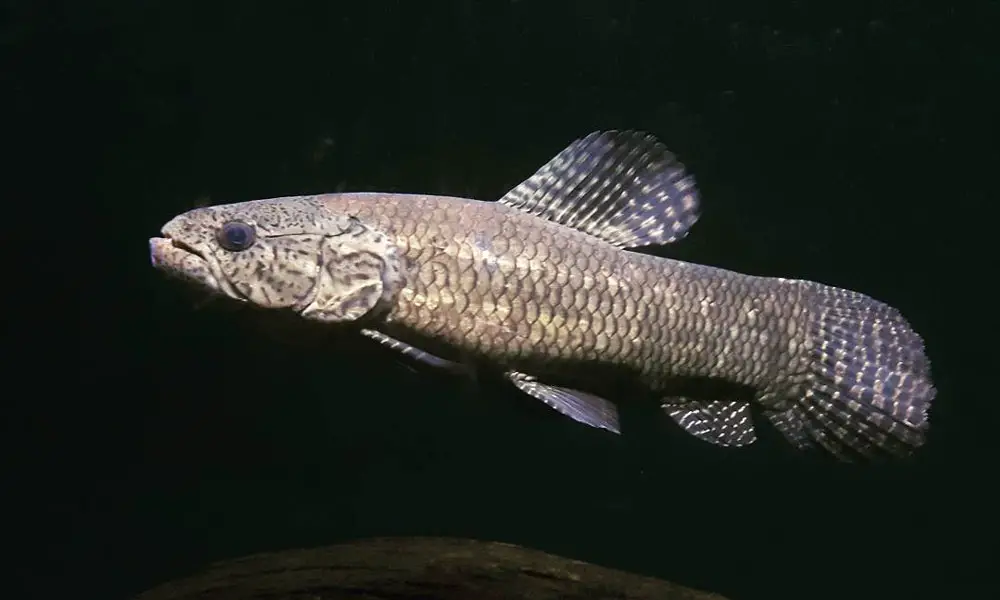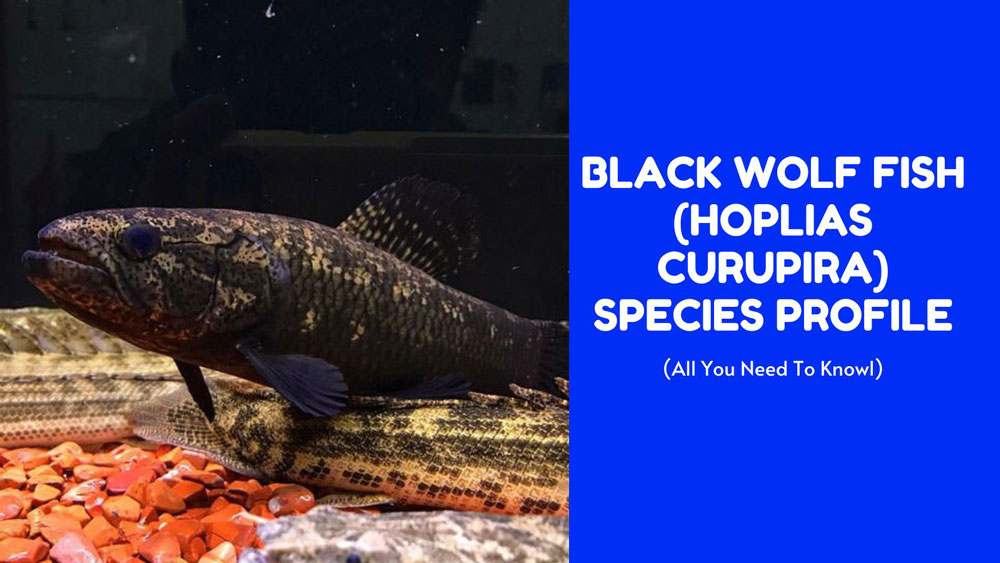If you’ve been around the hobby long enough, chances are you have already owned most of the common aquarium fish sale at pet stores.
Keeping some of the fiercest predators is probably a great next step for expanding your aquatic species collection and enriching your fish keeping skills and knowledge.
Black wolf fish is the perfect candidate for that.
This guide will go over everything you need to know about black wolf fish, from their behavior and diet in the wild to what it takes to keep them healthy in captivity.
Species Summary
The black wolf fish (Hoplias curupira) is a predatory species native to the Amazon River, and several of its major tributaries stretched across northern regions of South America.
It is named after a creature from Brazilian mythology, the ‘curupira,’ famed for protecting the forest and seeking revenge on those who bring harm to it. The comparison is apt for such an antagonistic species.
Black wolf fish are related to the various other species of wolf fish found all over South America and are able to survive in fairly difficult circumstances due to the fact that they can, surprisingly, breathe air; after a long drought, it’s not unusual for a hardy wolf fish to be the last survivor in a rapidly depleting mud pool.
Furthermore, Hoplias really do deserve their name. They are generally all extremely territorial and capable of being highly aggressive. The black wolf fish is no exception, though this doesn’t mean that they are not suitable for the well-prepared fish keeper’s aquarium.
| Scientific Name: | Hoplias curupira |
| Common Name: | Black Wolf Fish |
| Origin: | the north of South America |
| Family: | Erythrinidae |
| Size: | 16 inches (40cm) |
| Social: | Aggressive |
| Care: | Advanced |
| Lifespan: | At least 15 years |
| pH: | 6.0 to 7.5 |
| Temperature: | 74 to 86° F (23 to 30° C) |
| KH: | 0 – 5 dGH |
| Diet: | Carnivore |
| Tank Size: | 120 gallons (48″ x 24″ x 24″) |
What Does a Black Wolf Fish Look Like?

Black wolf fish are relatively thick-bodied, especially in relation to other members of the Hoplias genus. They have a blunt, round-shaped head which is especially noticeable when viewed from above, and a prominent, elongated dorsal fin that fans out prominently when the fish is agitated. Their eyes are small and dark and are sometimes difficult to distinguish.
In terms of coloration, they have a sandy brown and black flecked appearance, perfect for camouflaging themselves when approaching prey in a sandy Amazonian riverbed.
Their shading, however, can alter depending on the mood of the fish, moving from a light yellowish brown to a much darker hue of near black (giving the fish its common name of black wolf fish).
Most specimens will also display a thick dark stripe, which is occasionally outlined with lighter-colored scales, running along the flank of the fish from the tail to its rather prominent gills.
Last but not least, black wolf fish have a number of rows of razor-sharp teeth. Be sure to never let your fingers get too near them!
How Long Do Black Wolf Fish Live?
The black wolf fish was first formally described in 2009 – a fairly new addition to the aquarium hobby. There is not much information regarding its lifespan, but it is estimated that it can live at least 15 years, so a prospective owner must make a long-term commitment to fulfilling the needs of a black wolf fish.
Size & Growth Rate
Like most Hoplias species, black wolf fish can grow to quite a size, though they are in no means the largest of the wolffish.
Author note: The Gold Wolf Fish (Hoplerythrinus unitaeniatus) is the smallest wolffish, reaching just over 8 inches (20 cm).
Black wolf fish kept in home aquariums tend to grow smaller and usually grow no larger than 16 inches (40cm), while wild specimens have been known to reach up to 30 inches (75 cm) in length.
However, this happens at an extremely fast rate, with younger specimens growing by an inch per month, depending on how much you feed them.
Black Wolf Fish Care Guide
As has been mentioned, the wolffish family is generally quite aggressive, and the black wolf fish is no exception.
It has often been remarked that piranha is actually quite shy and passive compared to wolffish, so that should give you an idea of what we are talking about here.
This is reflected in their behavior toward other fish and even towards the owner. In fact, it is not unusual for poorly prepared owners to receive a nasty bite or for black wolf fish to be observed charging the aquarium glass or any contraption being used to ensnare them.
For these reasons, black wolf fish tend to be kept alone, although it is possible for them to be kept with other large fish which will not challenge them territorially (or fit in their mouth). Appropriate choices may be larger members of the cichlid family or characins of a similar size.
Tank Size
For this large fish, your tank should really be a minimum of 120 gallons (48″ x 24″ x 24″) though you may wish to consider an even larger aquarium, especially if you decide to house the fish with other tank mates.
Larger tanks with big footprints are generally considered better, so height is less important than the width in this case. The larger the aquarium, the more likely they will swim rather than hover in mid-water.
Crucially, the tanks must have a strong, tight-fitting lid because these fish are extremely good jumpers and will manage to get out of an aquarium if given a chance once too often.
Water Parameters
Like most fish from the Amazon, their habitats are often surrounded by quite dense plants.
As fruits, leaves, and branches that fall into the water decay, they leach tannins into the water, creating a soft, acidic environment to which black wolffish have grown accustomed. They are not picky, but extremes should be avoided.
Ideally, aquarium water should have a pH value of between 6.0 and 7.5 and be soft (with a general hardness of around 0-5 dGH). Temperature-wise these fish are not too sensitive, but anywhere between 74 to 86° F (23 to 30° C) will be fine.
Décor (Plants and Substrate)
In their natural environment, black wolf fish are found in relatively open waters with moderate water movement.
The aquarium can be fairly plain, but it is a good idea to recreate this by providing plenty of open space with natural-looking bogwood and roots for them to hide in.
Any plants (live or artificial) and bogwood that are used must be robust enough to withstand an occasional fly past by these lively predators. A dark-colored substrate of either sand or gravel will make this fish feel at home.
Behavior & Temperament
Black wolf fish (H. curupira) are notoriously aggressive and will be a threat to any smaller tank mates, who may be eaten whole. When they want to, black wolf fish can move extremely quickly, meaning the fish keeper must exercise caution when performing maintenance.
Aside from being a threat to other fish and the keeper, black wolf fish have even been known to attack filtration systems and any device used to trap them. Ensure your equipment is securely in place.
Black Wolffish Tank Mates
This aggressive nature and full-grown size make it difficult for many tank mates to live alongside black wolf fish. The only species that can truly be considered safe are larger, robust fish of similar size and temperament, such as other wolffish relatives or large SA & CA cichlids.
However, there’s always the caveat that Black Wolf Fish might decide to attack them anyway, even larger fish. There are also rumors of these fish peacefully co-existing with Stingrays, Arowanas, Brycons, Dorados and peacock bass, but it’s far from guaranteed.
Food & Diet
In the wild, these predators will spend the majority of their time hunting down smaller fish and large insects, and so, for this reason, live food is preferred. They will appreciate foods like worms, feeder guppies or goldfish, crawfish, and silversides.
However, over time they can be trained to eat frozen food and frozen food such as shrimp and mussels. They need to be fed regularly, at least two times per day.
Furthermore, these fish are generally less active in the day and more active at night; this is why you should feed them before you go to bed.
Breeding
Breeding black wolf fish is not known in captivity, but it may follow a similar pattern to other Hoplias species.
The biggest challenge is having a bonded pair of a similar size because the larger one will also try to attack the smaller one.
Most Hoplias members are very prolific and will spawn in pairs, with the female laying as many as 10,000 eggs. Therefore, a very large breeding tank of at least 400 gallons is required.
What’s more, the fry are difficult to raise and must be sorted according to size as they grow to prevent the smaller ones from being killed and eaten by their larger siblings.
Availability
Although black wolffish are not widely available, they can be found in specialist online stores and aquarist societies. Usually, they come with a very high price tag.
Be sure of what you are getting, though, as they are often sold as the most kept species: Hoplias malabaricus, which is much larger and requires a larger territory.
Bottom Line
For any keepers interested in predatory fish, black wolf fish should definitely be on your radar. Watching them feed can be a thrilling experience and will definitely make a good video clip for your social media.
However, it is important that they be housed in a large enough tank and be matched with fish big enough to avoid a sticky end.
Have any anecdotes that you’d like to share? Let us know in the comments!
